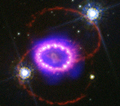Speaker
Dr
Salvatore Orlando
(INAF - Osservatorio Astronomico di Palermo)
Description
During the evolution of SNRs, Rayleigh-Taylor (RT) instability develop at the contact
discontinuity between the ejecta and the shocked interstellar medium (ISM). The
nonlinear instability evolves, giving rise to a turbulent structure with
preferentially radial components, the so-called RT fingers. Current multi-dimensional
models of SNRs describe the development of these structures. However they predict an
average distance between the contact discontinuity and the forward shock that is much
larger than that observed in many young SNRs (e.g SN1006, Tycho's SNR), and they
cannot explain the high number of knots observed to protrude ahead of the shock.
There is a growing consensus in the literature that density clumping of ejecta may
naturally emerge from supernovae explosions. This early ejecta structure can have
important consequences on the development of instability at the contact
discontinuity. Here we investigate the role played by the ejecta clumping in the
evolution of SNRs through a three-dimensional MHD model describing the expansion of
the remnant through a magnetized ISM, including consistently the initial ejecta
clumping and the effects on shock dynamics due to back-reaction of accelerated cosmic
rays.
Primary author
Dr
Salvatore Orlando
(INAF - Osservatorio Astronomico di Palermo)
Co-authors
Dr
Fabrizio Bocchino
(INAF - Osservatorio Astronomico di Palermo)
Dr
Marco Miceli
(Universita` di Palermo)
Maria Letizia Pumo
(INAF - Osservatorio Astrofisico di Catania)
Dr
Oleh Petruk
(Institute for Applied Problems in Mechanics and Mathematics, Naukova St. 3-b Lviv 79060, Ukraine)

